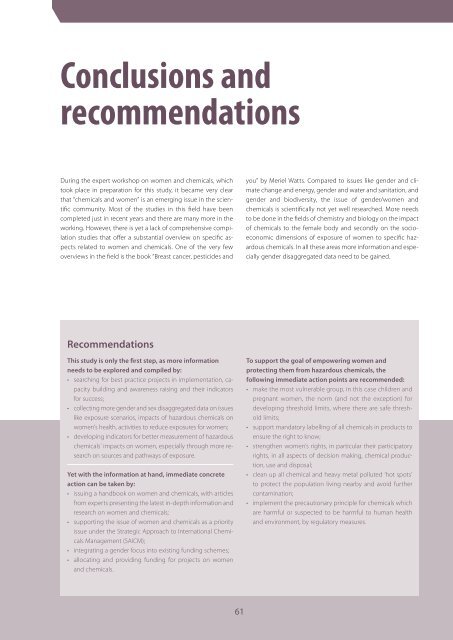Women and Chemicals
1ToENNR
1ToENNR
Create successful ePaper yourself
Turn your PDF publications into a flip-book with our unique Google optimized e-Paper software.
Conclusions <strong>and</strong><br />
recommendations<br />
During the expert workshop on women <strong>and</strong> chemicals, which<br />
took place in preparation for this study, it became very clear<br />
that “chemicals <strong>and</strong> women” is an emerging issue in the scientific<br />
community. Most of the studies in this field have been<br />
completed just in recent years <strong>and</strong> there are many more in the<br />
working. However, there is yet a lack of comprehensive compilation<br />
studies that offer a substantial overview on specific aspects<br />
related to women <strong>and</strong> chemicals. One of the very few<br />
overviews in the field is the book “Breast cancer, pesticides <strong>and</strong><br />
you” by Meriel Watts. Compared to issues like gender <strong>and</strong> climate<br />
change <strong>and</strong> energy, gender <strong>and</strong> water <strong>and</strong> sanitation, <strong>and</strong><br />
gender <strong>and</strong> biodiversity, the issue of gender/women <strong>and</strong><br />
chemicals is scientifically not yet well researched. More needs<br />
to be done in the fields of chemistry <strong>and</strong> biology on the impact<br />
of chemicals to the female body <strong>and</strong> secondly on the socioeconomic<br />
dimensions of exposure of women to specific hazardous<br />
chemicals. In all these areas more information <strong>and</strong> especially<br />
gender disaggregated data need to be gained.<br />
Recommendations<br />
This study is only the first step, as more information<br />
needs to be explored <strong>and</strong> compiled by:<br />
• searching for best practice projects in implementation, capacity<br />
building <strong>and</strong> awareness raising <strong>and</strong> their indicators<br />
for success;<br />
• collecting more gender <strong>and</strong> sex disaggregated data on issues<br />
like exposure scenarios, impacts of hazardous chemicals on<br />
women’s health, activities to reduce exposures for women;<br />
• developing indicators for better measurement of hazardous<br />
chemicals’ impacts on women, especially through more research<br />
on sources <strong>and</strong> pathways of exposure.<br />
Yet with the information at h<strong>and</strong>, immediate concrete<br />
action can be taken by:<br />
• issuing a h<strong>and</strong>book on women <strong>and</strong> chemicals, with articles<br />
from experts presenting the latest in-depth information <strong>and</strong><br />
research on women <strong>and</strong> chemicals;<br />
• supporting the issue of women <strong>and</strong> chemicals as a priority<br />
issue under the Strategic Approach to International <strong>Chemicals</strong><br />
Management (SAICM);<br />
• integrating a gender focus into existing funding schemes;<br />
• allocating <strong>and</strong> providing funding for projects on women<br />
<strong>and</strong> chemicals.<br />
To support the goal of empowering women <strong>and</strong><br />
protecting them from hazardous chemicals, the<br />
following immediate action points are recommended:<br />
• make the most vulnerable group, in this case children <strong>and</strong><br />
pregnant women, the norm (<strong>and</strong> not the exception) for<br />
developing threshold limits, where there are safe threshold<br />
limits;<br />
• support m<strong>and</strong>atory labelling of all chemicals in products to<br />
ensure the right to know;<br />
• strengthen women’s rights, in particular their participatory<br />
rights, in all aspects of decision making, chemical production,<br />
use <strong>and</strong> disposal;<br />
• clean up all chemical <strong>and</strong> heavy metal polluted ‘hot spots’<br />
to protect the population living nearby <strong>and</strong> avoid further<br />
contamination;<br />
• implement the precautionary principle for chemicals which<br />
are harmful or suspected to be harmful to human health<br />
<strong>and</strong> environment, by regulatory measures.<br />
61


